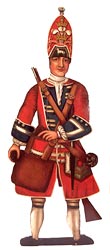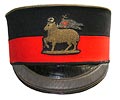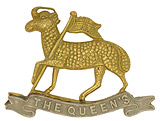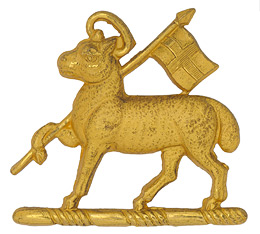In Search of The Lamb
Badges of the West Surreys The Queen's Royal Regiment
Philip J Haythornthwaite
Of those regimental badges which incorporate symbols quite unique to one unit, one of the most distinctive is the Paschal Lamb device of the old 2nd (Queen's Royal) Regiment of Foot, which in 1881 became The Queen's Royal West Surrey Regiment. The Paschal Lamb was an early Christian symbol, deriving from the lamb eaten at the Jewish festival of Passover (hence Paschal), and in its conventional form is represented as a lamb with a halo above its head, supporting over one shoulder a flag bearing the device of St George, a red cross upon a white field. Although used from an early period, the reason for its association with the 2nd Foot is obscure.
The 2nd Foot was raised in 1661 by Henry Mordaunt, 2nd Earl of Peterborough, for service at Tangiers, a colony that formed part of the dowry of Catherine of Braganza, Queen of Charles II. By tradition, the Paschal Lamb derived from the arms of the Queen's Portuguese family, but this seems not to have been the case, as a lamb does not feature in the heraldry of the house of Braganza. It may be that the lamb was associated with Catherine personally; her father, King John IV of Portugal, appears to have had St John the Baptist as his patron saint, and in depictions of St John a lamb is usually featured, and it is possible that Catherine adopted his symbol unofficially. Indeed, the portrait by Jacob Huysman in the Royal Collection shows Catherine with four lambs, although this may not be significant (it also includes a duck in the foreground, and a cherub!), as a number of portraits of ladies of the court of that period also include lambs, although it is possible that the Queen may have set that fashion.
Among other possibilities for the origin of the device, it may be that St John the Baptist featured in the decoration of the Cathedral at Tangiers, and the regiment may have taken it from its service there; indeed, considering the non-Christian enemy fought at Tangier, a Christian religious symbol would have been appropriate for the defenders of the outpost. However, it may be that the earliest evidence for the use of the device post-dates the regiment's return to England in 1684, and it was certainly not used on the regimental colours in the early years of James II's reign. A flag which bears three lambs and was reputedly brought to England by William III may have no relevance to the regiment, if indeed it does date from that period. In this connection, it has also been suggested that the Paschal Lamb may be derived from the arms of the Rowe family, which like some others used it as a crest, and a Henry Rowe was lieutenant-colonel of the regiment in 1689, having joined in 1682. It is unlikely, however, that a lieutenant-colonel would have been permitted to put his arms on the regimental Colours even if, as has been suggested, he was (or was connected to) a Rowe who assisted William ill at the time of the 'Glorious Revolution' and was rewarded by having his crest adopted as a regimental badge - a theory for which no evidence seems to exist.
 |
| Carlisle Figure 1715. |
It may not be coincidence that the regiment was nicknamed 'Kirke's Lambs' at an early period, relating to the colonelcy of Piercy (sic) Kirke (April 1682 December 1691), and the 18th century sources refer to the lamb as the regiment's 'ancient badge' - for example, in the 1751 Clothing Warrant, in which the device is recorded as appearing in three comers of the Regimental Colour. However, the earliest surviving depiction appears to be upon two life-size 'dummy boards' (painted, cut-out figures) which portray the uniform of regimental grenadiers in the early 18th century. Upon the front flap of their mitre caps is displayed the lamb device, but without halo or flag; indeed, the addition of these features probably occurred as late as the early 19th century. The 1768 Clothing Warrant, while mentioning the use of the 'ancient badge' of the lamb on the three comers of the Regimental Colour, specified that the badge on the grenadier caps should be the King's crest, cipher and crown, and an engraving which appears to depict the lamb upon the plate of 1768 grenadier cap may perhaps have been confused with the antelope badge of the 6th Foot.
 |
| Officers Shako 1861-69 |
However, the Paschal Lamb was defmitely carried upon the officers' plate of the 1816 'Regency' shako, the central disc of which bore a silver Paschal Lamb and sphinx below scrolls inscribed 'Peninsular' and with the old regimental motto 'Pristinae Virtutis Memor', with the inscription 'The Queen's Royals' at the base. The officers' shoulder belt plate from about 1830 displayed the Paschal Lamb on the ground on blue enamel, surrounded by a pierced, enamel-backed strap inscribed 'Pristinae Virtutis Memor' (the backing to the strap also recorded in red enamel) and a similar central design was carried on the officers' plate of the succeeding 1829 shako, for which two designs are recorded.
The first consisted of an eight-pointed gilt star with a crown covering the upper point, upon which was affixed a silver diamond-cut star bearing battle-honours on the longest side 'rays', at the right from top to bottom, 'Vittoria' over 'Nivelle' over 'Peninsula', and at the left, 'Salamanca' over 'Pyrenees' over 'Toulouse'. In the centre was the lamb over '2' within the strap as on the belt plate, with a sphinx upon a tablet inscribed 'Egypt " backed by a laurel wreath, between the top of the strap and the base on the crown. The honours 'Vimiera' and 'Gorunna' were awarded in June 1833, necessitating an alteration in the shako plate; the second pattern had a similar back-plate, silver diamond-cut star and central device, but with the honours removed from the rays of the star and carried instead on scrolls intertwined among a large laurel wreath which surrounded the central strap on the right, 'Vimiera' 'Salamanca, 'Pyrenees' and 'Toulouse', and on the left 'Corunna' 'Vittoria', 'Nivelle' and 'Peninsula'.
Three new honours were authorized in July 1840, and appeared on the officers' plate of the 1844 (Albert) shako. The usual crowned-star plate bore a wreath of palm (right) and laurel (left) upon which were the new honours, 'Khelat' (right) and 'Ghunzee' (left), and below them the previous honours, 'Salamanca', 'Pyrenees', and 'Nivelle' (right), 'Vimiera', 'Corunna' and 'Vittoria' (left) with 'Toulouse' at the base. Within the wreath was a circlet bearing 'Pristinae Virtutis Memor' enclosing '2'; below was the new honour 'Afghanistan' on a scroll, and below that the Paschal Lamb; above the wreath was a sphinx above a scroll inscribed 'Peninsula'. The general pattern plates of the other ranks were distinguished only by the regimental number.
 |
| Other Rank's Gelngarry Badge 1874-81. |
The number continued to be the only distinction on the other ranks' plates, but officers' plates were more elaborate; the 1855 plate, for example, was of the general pattern, a gilt, eight-pointed rayed star with a crown covering the upper ray, bearing in the centre a voided Garter surrounding the Paschal Lamb over '2' in silver. The same device was displayed in the centre of the Garter of the 1869 shako plate, which is recorded both entirely in gilt, and gilt with silver central devices. The collar badge worn from the early 1870's consisted of the Paschal Lamb standing upon a torse (heraldic wreath) in brass.
The Glengarry badge (worn from 1871) consisted of a voided strap inscribed 'Queen's Royal' with '2' in the centre and a Paschal Lamb on top of the strap, in brass. From 1874 officers were authorised to use a Paschal Lamb over '2', in gold embroidery, upon their forage caps. Although the regiment avoided amalgamation in the reorganisation of 1881, their regimental number was discontinued and their title altered to The Queen's (Royal West Surrey Regiment). This was the first time that a county affiliation had been included in the regimental title, the old 2nd Foot being one of the few to avoid this linkage when county titles were first allocated in 1782. (At that time, when consulted, the regiment reported that it did not want a county affiliation - presumably its royal title was regarded as sufficiently distinguished - and that its primary recruiting districts at that date were Halifax, Bradford and Wakefield).
New insignia was required after the discontinuance of the regimental number. For example, the other ranks' 1878 helmet had a plate-centre comprising a brass circlet inscribed 'West Surrey' enclosing a white metal Paschal Lamb in the voided centre. In the centre of the officers' helmet plate the lamb was in silver, upon a ground of scarlet velvet, with a lower scroll inscribed 'The Royal West Surrey Regiment' from 1911 an additional scroll was added, below the crown on the helmet plate, inscribed 'The Queen's'. The cap badge consisted of the Paschal Lamb in brass, upon a white metal scroll inscribed 'The Queen's " at this stage, as before, the lamb carried its flag over its left shoulder, and the flag was in the form of a swallow-tailed guidon, although the lamb on the other ranks' helmet plate centre carried the flag over the right shoulder. The collar badge was similar, initially with the lamb upon a tablet inscribed 'Queen's' and then upon a white metal scroll as for the cap badge.
 |
| Officers Forage Cap 1881-1902. |
For officers, the 1891 regulations describe the forage-cap badge as consisting of the Paschal Lamb in gold embroidery, with a silver flag bearing a crimson cross; and for the forage or field cap for active service and manoeuvres, a gilt crowned Garter, surrounding a silver Paschal Lamb on scarlet velvet. Their collar badge was the lamb in frosted gilt. The 1900 regulations note that their collar badge was a gilt Paschal Lamb upon a silver scroll bearing 'The Queen's' and while the embroidered forage cap badge remained unchanged, the field cap badge now resembled the left collar badge, i.e like the other ranks' cap badge but in gilt upon a silver scroll. The 1911 regulations note that this badge was restricted to the tunic and frock coat; for the mess jacket the collar badge was an embroidered Paschal Lamb in gold, silver and crimson, without the scroll. The 1911 regulations also noted that for service dress, the bronze cap badge was like the previous field cap badge, and the collar badges the same (with scroll), in pairs.
 |
| Lamb with scroll 1881-1924. |
In the 1881 reorganisation, the old 2nd Royal Surrey Militia became the 3rd Battalion of The Queen's, and the four Surrey Volunteer corps became the regiment's 1st/4th Volunteer Battalions. Volunteer battalions usually wore additional titles to identify the battalion. For those of The Queen's helmet-plates resembled those of the regular battalions but were blackened, the other ranks' plate-centre inscribed 'West Surrey/1st Volunteer Bttn', 'West Surrey/2nd Volunteer Bttn' etc; the 4th Volunteer Battalion had a blackened, crowned Maltese cross plate, bearing the same circlet and device in the centre. Glengarry badges were formed by affixing a crown to the top of a white metal helmet plate centre, which might bear the battalion identification on the circlet as for the helmet plate, although a white metal regular pattern badge is also recorded; the 3rd Battalion had a white metal regular pattern badge with brass Paschal Lamb. Officers' helmet plates were like those of the regulars, silver or blackened, with an additional lower scroll identifying the battalion Cap badges resembled those of the regular battalions with an altered scroll, which read (for example) '2nd V.B. The Queen's', '3rd V.B. The Queen's'; blackened for the 1st and 2nd but white metal is recorded for the 3rd . The 4th had a different pattern, in which metal, with the Paschal Lamb upon a patch of 'grass' over a large '4th " over a scroll inscribed 'Volr/Battn/Queen's '.
In 1908 the 3rd and 4th Volunteer Battalions left the regiment to become the 22nd and 24th Battalion London Regiment respectively, while the 1st and 2nd Volunteer Battalions became the 4th and 5th Territorial Battalions of The Queen's; they wore the regular cap badge, but for the 5th Battalion it was blackened. During World War I an all-brass economy version of the regimental cap badge was produced.
 |
| Lamb with bar only 1924-1959. |
In 1920 the regimental title changed to The Queen's Royal Regiment (West Surrey), and a new badge was authorised in 1924. The design of the Paschal Lamb was altered, now standing upon a torse instead of upon a title-scroll, with a square banner supported over the animal's right shoulder, all in brass. A plastic economy version in light bronze colour was produced during World War II, and a smaller version for wear in the beret was authorised in 1949, in brass, and subsequently in gold-anodised aluminium. The collar badge design changed accordingly. In 1959 The Queen's was amalgamated with the East Surrey Regiment to form The Queen's Royal Surrey Regiment, the badge for which consisted of the Paschal Lamb superimposed upon a crowned, eight-pointed, diamond-cut star, the lamb in gold anodised aluminium and the star in silver. When The Queen's Royal Surrey Regiment was merged into The Queen's Regiment in 1966, the Paschal Lamb fmally ceased to be used as a head-dress badge.
References
Comments on the origin of the Paschal Lamb device may be found in articles by D L Lloyd Owen and W Y Carman, in the Journals of the Society for Army Historical Research Vols XXXIV and XXXV (1956-57), and by Brig, A P Block in the Journal of the Queen's Royal Surrey Regiment 1956-66.
MEDAL NEWS JUNE/JULY 2002
Related Links
